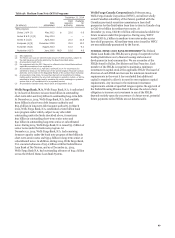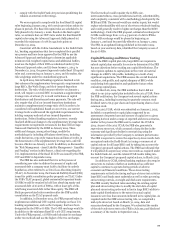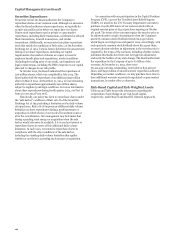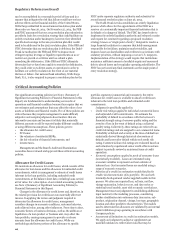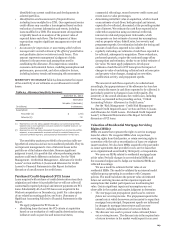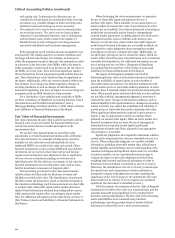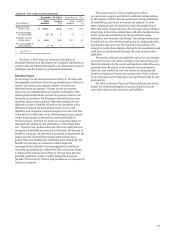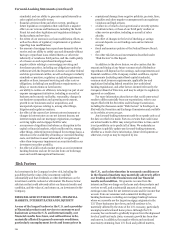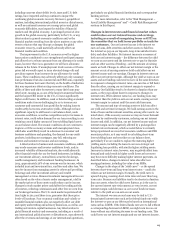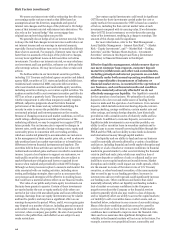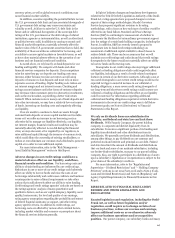Wells Fargo 2014 Annual Report Download - page 109
Download and view the complete annual report
Please find page 109 of the 2014 Wells Fargo annual report below. You can navigate through the pages in the report by either clicking on the pages listed below, or by using the keyword search tool below to find specific information within the annual report.compliance date to give banking entities until July 21, 2016,
to conform their ownership interests in and sponsorships of
covered funds that were in place prior to
December 31, 2013, and the FRB has announced that it
intends to provide an additional one-year extension to this
date in the future. As a banking entity with more than
$50 billion in consolidated assets, we will also be subject to
enhanced compliance program requirements. At this time,
we do not anticipate a material impact to our financial
results from the rule as prohibited proprietary trading and
covered fund investment activities are not significant to our
financial results. Moreover, we already have reduced or
exited certain businesses in anticipation of the rule’s
compliance date and expect to have to make limited
divestments in non-conforming funds as a result of the rule.
• Regulation of swaps and other derivatives activities. The
Dodd-Frank Act established a comprehensive framework for
regulating over-the-counter derivatives and authorized the
CFTC and the SEC to regulate swaps and security-based
swaps, respectively. The CFTC and SEC jointly adopted new
rules and interpretations that established the compliance
dates for many of their rules implementing the new
regulatory framework, including provisional registration of
our national bank subsidiary, Wells Fargo Bank, N.A., as a
swap dealer, which occurred at the end of 2012. In addition,
the CFTC has adopted final rules that, among other things,
require extensive regulatory and public reporting of swaps,
require certain swaps to be centrally cleared and traded on
exchanges or other multilateral platforms, and require swap
dealers to comply with comprehensive internal and external
business conduct standards. Also included in this regulatory
framework are so-called push-out provisions affecting U.S.
banks acting as dealers in commodity swaps, equity swaps
and certain credit default swaps, which require that these
activities be conducted through an affiliate. These push-out
provisions have since been amended to apply only to
structured finance swaps. Margin rules for swaps not
centrally cleared have been proposed, and in September
2014 were re-proposed. If adopted as re-proposed, the
margin and capital requirements for swaps not centrally
cleared may significantly increase the cost of hedging in the
over-the-counter market. All of these new rules, as well as
others being considered by regulators in other jurisdictions,
may negatively impact customer demand for over-the-
counter derivatives and may increase our costs for engaging
in swaps and other derivatives activities.
• Changes to asset-backed securities (ABS) markets. The
Dodd-Frank Act requires sponsors of ABS to hold at least a
5% ownership stake in the ABS. Exemptions from the
requirement include qualified residential mortgages
(QRMs) and FHA/VA loans. In October 2014, federal
regulatory agencies issued final rules to implement this
credit risk retention requirement, which included an
exemption for the GSE’s mortgage-backed securities. The
final rules also aligned the definition of QRMs, which are
exempt from the risk retention requirements, with the
Consumer Financial Protection Bureau’s definition of
“qualified mortgage.” In addition, the final rules addressed
the measures for complying with the risk retention
requirement and continued to provide limited exemptions
for qualifying commercial loans, qualifying commercial real
estate loans, and qualifying automobile loans that meet
certain requirements. We continue to evaluate the final
rules and assess their impact on our ability to issue certain
asset-backed securities or otherwise participate in various
securitization transactions.
• Enhanced regulation of money market mutual funds. On
July 23, 2014, the SEC adopted a rule governing money
market mutual funds that, among other things, requires
significant structural changes to these funds, including
requiring institutional prime money market funds to
maintain a variable net asset value and providing for the
imposition of liquidity fees and redemption gates for all
non-governmental money market funds during periods in
which they experience liquidity impairments of a certain
magnitude. The SEC has provided a period of two years
following the effective date of the rule for funds to comply
with these structural changes.
• Regulation of interchange transaction fees (the Durbin
Amendment). On October 1, 2011, the FRB rule enacted to
implement the Durbin Amendment to the Dodd-Frank Act
that limits debit card interchange transaction fees to those
reasonable and proportional to the cost of the transaction
became effective. The rule generally established that the
maximum allowable interchange fee that an issuer may
receive or charge for an electronic debit transaction is the
sum of 21 cents per transaction and 5 basis points
multiplied by the value of the transaction. On July 31, 2013,
the U.S. District Court for the District of Columbia ruled
that the approach used by the FRB in setting the maximum
allowable interchange transaction fee impermissibly
included costs that were specifically excluded from
consideration under the Durbin Amendment. In August
2013, the FRB filed a notice of appeal of the decision to the
United States Court of Appeals for the District of Columbia.
In March 2014, the Court of Appeals reversed the District
Court’s decision, but did direct the FRB to provide further
explanation regarding its treatment of the costs of
monitoring transactions. The plaintiffs did not file a petition
for rehearing with the Court of Appeals but filed a petition
for writ of certiorari with the U.S. Supreme Court. In
January 2015, the U.S. Supreme Court denied the petition
for writ of certiorari.
Regulatory Capital Guidelines and Capital Plans
During 2013, federal banking regulators issued final rules that
substantially amended the risk-based capital rules for banking
organizations. The rules implement the Basel III regulatory
capital reforms in the U.S., comply with changes required by the
Dodd-Frank Act, and replace the existing Basel I-based capital
requirements. We were required to begin complying with the
rules on January 1, 2014, subject to phase-in periods that are
scheduled to be fully phased in by January 1, 2022. In 2014,
federal banking regulators also finalized rules to impose a
supplementary leverage ratio on large BHCs like Wells Fargo
and our insured depository institutions and to implement the
Basel III liquidity coverage ratio. For more information on the
final capital, leverage and liquidity rules, and additional capital
requirements under consideration by federal banking regulators,
see the “Capital Management” section in this Report.
“Living Will” Requirements and Related Matters
Rules adopted by the FRB and the FDIC under the Dodd-Frank
Act require large financial institutions, including Wells Fargo, to
prepare and periodically revise resolution plans, so-called
“living-wills”, that would facilitate their resolution in the event of
material distress or failure. Under the rules, resolution plans are
required to provide strategies for resolution under the
Bankruptcy Code and other applicable insolvency regimes that
107




